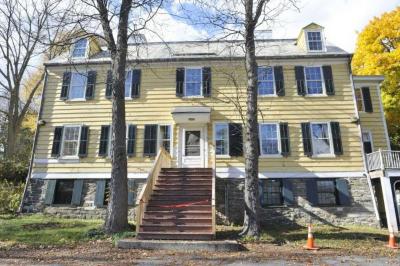Maria Schuyler Sanders Van Rensselaer's Receipt Book from 1760-1834
View Online
Manuscript Cookbooks Survey Database ID#
1517Place of Origin
United States ➔ New York ➔ AlbanyDate of Composition
1760-1834Description
This book belonged to Maria Sanders Schuyler Van Rensselaer (1749-1830). Born into a wealthy merchant family in Albany, New York, she married (at age 19) Philip Van Rensselaer (1747-1798), a scion of one of New York's most prominent and elite Dutch-American families. The couple had fourteen children, thirteen of whom survived childhood. Philip was an importer of West Indian products, a farmer, and a real estate speculator. During the American War of Independence, which he supported in several different ways, Philip was often taken away from home and left Maria in charge of his business affairs, as numerous surviving letters between the couple attest. The timber mansion built for Philip and Maria in Albany, New York, which is now the historical site called Historic Cherry Hill, was finished in 1787. After Philip died, at age 51, Maria continued to live at Cherry Hill until her own death.Maria's book comprises 130 written pages bound together in a notebook (apparently missing its covers) and twenty-nine loose sheets originally inserted in the notebook, which the museum has digitized separately and arranged as pages 131-154 in the digital view. The first eight pages of the notebook contain thirty-three numbered recipes penned in a fine, formal eighteenth-century hand. These pages were written by Maria Sanders between 1760 and 1768, as a note on the bottom of page 1 clearly indicates. Who wrote the remainder of the book is a matter of conjecture, as pages 9 through 130 contain as many as twenty different hands. One of the unknown hands may well be Maria's, but in a more informal style than the fine formal eighteenth-century hand of the first eight pages. Another hand has been determined by the museum to be Maria's husband's, who wrote notes about farming and animal husbandry. The remaining hands are not identified, but they are presumed to belong to other Van Rensselaer family members or associates.
When pages 9 through 130 of the notebook were written is slightly clearer. Pages 23, 26, 29, and 35 contain the dates 1709, 1786, 1760, and 1785 respectively. But these dates are not written in hand of the recipes on these pages and were likely added later. Page 41 is headed "Receipts Feb 16 1822," so it can be presumed that the bulk of the book is of the nineteenth century. Two recipes for plum cake, or fruitcake, on pages 85 and 86, are dated 1830 and 1834 respectively. (The earlier recipe is attributed to Maria Van Rensselaer, who died the same year.) There are sporadic dates in the 1830s from page 87 to the end of the notebook, so the book was clearly continued beyond Maria's death--but perhaps not beyond 1830s. (The inserts, however, include some material that is much later.)
The bulk of the recipes are culinary, and they mostly outline puddings, pies, cakes, and desserts, with a smattering of recipes for meats, vegetables, savory sauces, cheeses, and wines. There are also some medical and household recipes, particularly toward the end of the notebook. Most of the culinary recipes reflect the British-American hybrid cooking fashionable among well-to-do Americans during the Federal era. But there are also some distinctively Dutch or Dutch-American recipes, including "Krullen" (crullers, page 5); "New Years Cokey" (cookies; page 6), "Oley Cook" (the original American doughnuts, page 6); "Doot Cockjes" ("death cookies," plain, saucer-size cookies given out at funerals, page 13); "Puffard" (a fruited bread served at tea, page 14); "Condale" (a custard-like drink, made with wine and eggs, often given to women after childbirth, page 18); and "Ballabuyshes" (puffy ball-shaped pancakes more commonly known as poffertjes, page 19).
Some of the more unusual recipes are "Carviair" (page 37), which is salted and dried, like bottarga; "Punkion Sweetmeat" (page 50); homemade macaroni and vermicelli (page 53); various rose preparations, including rose water, rose conserve, rose oil, and rose syrups (pages 64-5); "Parsnip Wine" (page 80): a catsup made with butternuts rather than the usual green walnuts (page 98); "Yeast of Pease" (page 105), and "Potato Bread" (also page 105). There is a lengthy list of fruits, vegetables, and herbs that are to be dried in the summer on page 123. The two plum cakes referred to above (on pages 85 and 86) are lightened with pearl ash, the earliest American "baking soda," and are darkened with a little molasses, distinctively American modifications that show this classic British cake in transition to American dark fruitcake.

